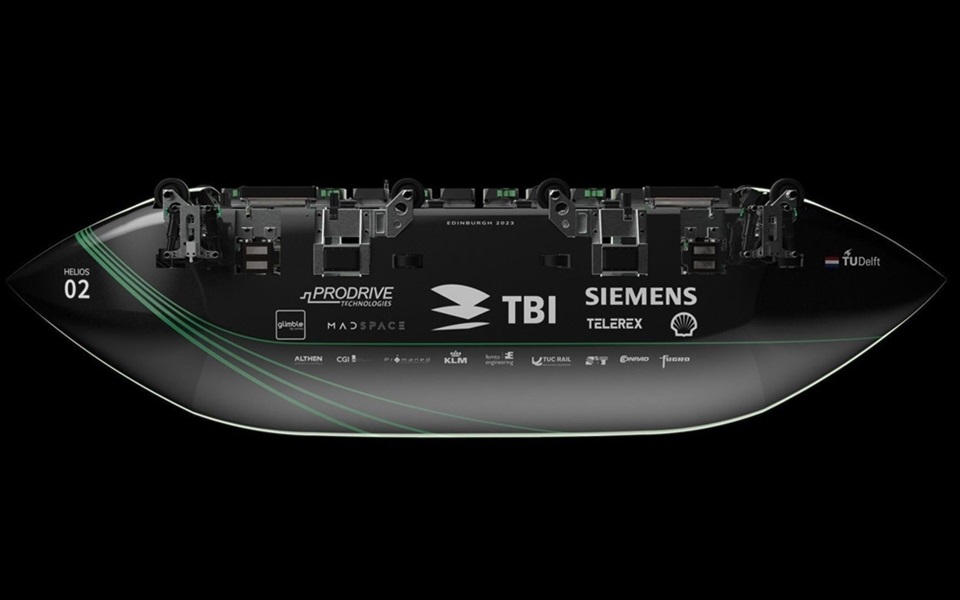Hyperloop - cooling in a vacuum

Delft Hyperloop cools in vacuum with Thermal Interface Material
Telerex Contributes to Innovative Heat Battery
How do you cool in a vacuum, where heat transfer via convection and conduction is not possible? This was the central question faced by the student team of Delft Hyperloop. The team found the solution in a heat battery that works based on a phase change material. With support from Telerex, an apparently 'half idea' was transformed into a successful application within a year.
The hyperloop is set to become the fifth leading mode of transport after the car, train, airplane, and boat. In this super-fast transport, magnetically propelled 'pods' (the vehicles) are shot at high speed through a vacuum tube. Due to the low resistance, speeds of over 1000 kilometers per hour are possible. A trip from Amsterdam to Paris would then take only half an hour. The hyperloop is faster than the airplane, but much more energy-efficient.
"We started with a half idea, and without the experience to bring that idea to life. Telerex and OTS gave us the confidence that we were on the right track. Ultimately, we succeeded in completing a complex engineering project within the available time."
Scalability is Crucial
With the promise of supersonic speeds, the hyperloop can change the future of transport and travel. And that future might be closer than we think. For example, there are plans for a hyperloop route between the regions of Rotterdam and Amsterdam. Via this route, products such as flowers and medicines can be transported quickly, for example to Schiphol Airport.
"Ultimately, you want to be able to integrate such a route into a European or even global network," says Kevin Tran, Lead Thermal Management of Delft Hyperloop during the past academic year. "Then you need to think carefully about the efficiency and scalability of the infrastructure. These were important points of focus for our team."
Making Infrastructure Cheaper
The Delft Hyperloop team from the Technical University of Delft is one of sixteen teams that contribute competitively to the ongoing development of the hyperloop. About forty students from TU Delft interrupt their studies for a year to work on this project. The goal is not to develop a hyperloop from start to finish, but rather to accelerate its implementation through smaller innovations.
During the European Hyperloop Week in July 2022, Delft Hyperloop won first prize for the best hyperloop prototype with the Helios I. "The team of that year had developed a motor that enables incredibly high speeds," says Joep Raithel, Lead Engineer Propulsion of the Delft Hyperloop team participating in the competition in July 2023. "The downside of that design was that all expensive components were in the track, making the infrastructure itself very expensive, which makes the concept not scalable."
Relocating Electrical Components
"For our prototype, we chose to place our energy-efficient magnetic motor not in the track but in the pod. As a result, the infrastructure is nothing more than a dumb piece of steel," continues Raithel. To eliminate rolling resistance, the Helios II also uses electromagnetic fields in both the vertical and lateral directions. The pod thus floats completely through the track.
However, this concept has a significant drawback: the electrical components generate a lot of heat in the pod. "And you can't easily get rid of that heat in a vacuum tube, because in a vacuum there is very high thermal resistance, which insulates the system," Tran explains. With the Helios I, cooling was done using cooling water, but that approach doesn't work when the heat is generated in a moving pod.
New Cooling System Needed
"So we needed an efficient cooling system inside the pod to store the heat," Tran explains. "We found the solution in a heat battery, using a phase change material, in our case a type of wax. This material starts as a solid, but once heat is added, it melts and turns into a liquid. During this phase change, a significant amount of energy can be stored."
"The material must be thermally conductive but not electrically conductive to prevent short circuits," says Lex van Huuksloot, Account Manager Thermal Management, EMC Products & Enclosures at Telerex. As a partner, Telerex supports Delft Hyperloop with advice and quick delivery of components. "Additionally, it must be fireproof."
Successful Collaboration
Norbert Engelberts from Optimal Thermal Solutions (OTS) acted as the 'thermal management doctor' during the development, validating the idea for the new cooling system. Telerex supplied the fans and heatsink that store the heat in the battery and the advanced thermal connection from Spanish CoolMag for heat transfer at the drive coils for optimal temperature control. Van Huuksloot: "An important advantage of CoolMag is that it contains no harmful substances. You can even handle it without gloves or a face mask."
Tran and Raithel look back on a successful collaboration with OTS and Telerex. "We started with a half idea, and without the experience to bring that idea to life," Raithel recalls. "Telerex and OTS gave us the confidence that we were on the right track. Ultimately, we succeeded in completing a complex engineering project within the available time. That's quite unique. At large tech companies, projects always run over time."
